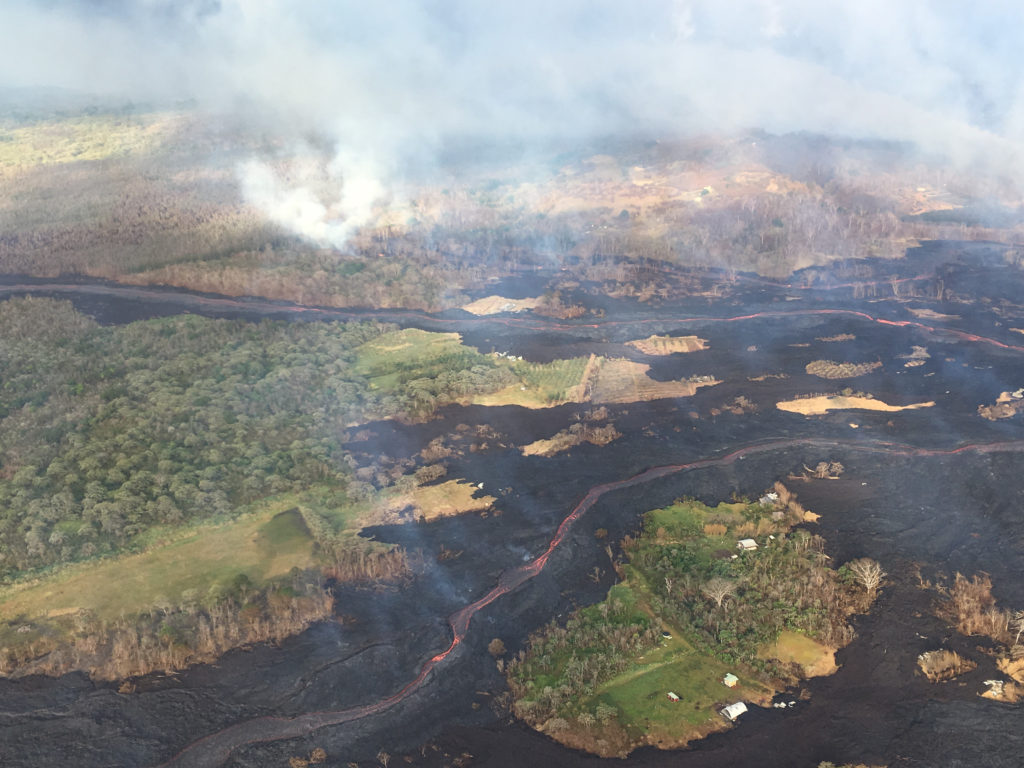Noon Update: Eruptions and Lava Flows Continue
UPDATE: Tuesday, May 22, 2018 at noon
Hawaiian Volcano Observatory continues to monitor highly active vents and lava flows. Fissure 20 is feeding one flow entering the ocean, while other fissures are supplying additional flows. Sulfur dioxide emissions remain high, causing elevated levels in areas downwind of the vents.

View during an early morning overflight of Kīlauea Volcano’s lower East Rift Zone. Two fissures (not pictured) are sending lava down two channels that merge near the coast. Click to enlarge. (USGS Photo)
The explosive eruption that occurred at 3:45 Tuesday, May 22, 2018, at the Kilauea summit resulted in an ash plume that reached a height of 8,000 feet. Ash has been reported in communities downwind of Kilauea. Take action to avoid exposure to ash.
Fissures near Puna Geothermal Venture are active and producing lava slowly flowing onto the property. This activity has destroyed the former Hawaii Geothermal Project site area adjacent to PGV.
Due to this activity, the following policies are in effect:
- At this time this situation is being closely monitored. There is no immediate threat to any of the wells at PGV.
- Due to high sulfur dioxide emissions, all media escorts near the fissures are postponed until further notice for safety.
- Due to the laze hazard at the lava ocean entry stay out of the plume.
- Take precautions to protect yourself from ash fallout and hazardous gases.
- Residents in the affected area should be prepared to leave the area with little notice due to gas or lava inundation. Take action necessary to prepare ahead of time.
On roads, the following roads are closed:
- Highway 137 is closed between Kamaili Road and Pohoiki Road.
- Kapoho and Kalapana Roads are open to residents only with identification.
An eruption community information meeting will be held at the Pahoa High cafeteria tonight, Tuesday, May 22, 2018 at 5:30 p.m.
Original Post:
This is a Hawai‘i County Civil Defense Message for Tuesday, May 22, 2018.

Panorama of Lower East Rift Zone Camera from Lower East Rift Zone [PGcam] Last Updated May 22, 2018 at 8:06 a.m.
Due to this activity, the following policies are in effect:
- At this time this situation will be closely monitored. There is no immediate threat to any of the wells at PGV.
- Due to the laze hazard at the lava ocean entry stay out of the plume.
Due to hazardous conditions, the following roads are closed and all are asked to stay out of the area:
- Highway 137 is closed between Kamaili Road and Pohoiki Road.
- Kamaili Road is closed to all thru traffic.
An eruption community information meeting will be held at the Pahoa High cafeteria on Tuesday, May 22 at 5:30 in the evening.

By the end of the afternoon on Monday, May 21, 2018, only a single ocean entry was active. The lava channel originates from fissure 22. This photo was taken during a late afternoon overflight of the lower East Rift Zone, Kīlauea Volcano.
Hawaiian Volcano Observatory reports that an explosive eruption at Kīlauea summit has occurred at about 3:45 a.m. The resulting ash plume may affect the surrounding areas. The wind may carry the ash plume to the southwest toward Wood Valley, Pahala, Na‘alehu and Waiohinu.
- The danger from this eruption is ash fallout. The major response is to protect yourself from fallout.
- If you are at home, stay indoors with the windows closed. Turn on your radio and listen for updates from authorities.
- If you are in your car, keep the windows closed. Ash fallout may cause poor driving conditions, due to limited visibility and slippery driving conditions. Drive with extreme caution, or pull over and park.
- After the hazard has passed, do check your home, and especially your catchment system for any impact that may affect your water quality.















